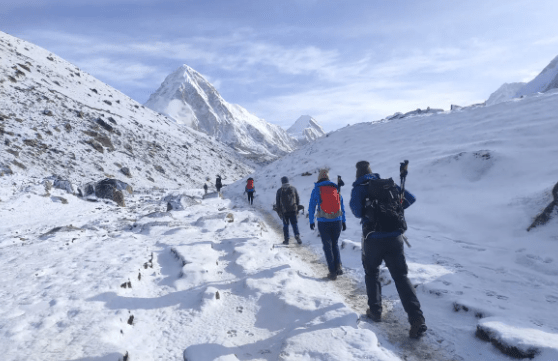Not only is Everest Base Camp accessible to daring explorers. It can make for an incredible family adventure with good planning. Find out how families may take their children on this famous hike and make lifelong memories.
One of the most well-known experiences in the world, the Everest Base Camp trek offers a hiking route unlike any other. It is thrilling, full of visual pleasures, adventurous, and revitalizing for the culture.
But have you ever considered what it could be like to travel to Everest Base Camp with children in tow, turning the trek into a family outing as opposed to a solitary one? Is it even feasible to do that?
We do, however, possess the answers to your queries. First and foremost, it is feasible to hike to the Everest Base Camp with children. Trekking to Everest Base Camp is not age-restricted, despite what many misconceptions claim.
That being said, the experience may change somewhat from what it otherwise would have been. Before embarking on this unusual family vacation, a number of other aspects should be taken into account. You will also need to make additional plans and preparations for the trip.
Everything you need to know to get ready for a successful Everest Base Camp trip with kids and family is included in this blog. So continue reading and get started!
Is Everest Base Camp Trek suitable for kids?
On the internet, many dispute over the appropriate age for children to hike to Everest Base Camp. Some believe that children should be five years old, while others believe that they should be ten or twelve.
You won’t know whether to take your child on this once-in-a-lifetime adventure if you read everything that has to be read. Let’s make it easier for you now.
The inability of those beyond a particular age to complete the Everest Base Camp trip is primarily attributed to their lack of maturity and physical and mental preparedness for the challenging terrain.
Thus, 10 years old is typically seen to be the ideal age for kids who will appreciate the trek’s charm rather than struggle and grow miserable along the way.
You can, however, defy the general age rule if you are well-prepared, have received the necessary training, and take into consideration your children’s physical condition, tolerance to altitude, and excitement for outdoor sports. And similar exceptions have happened in the past.
A number of youthful explorers have successfully completed the Short Everest Base Camp Trek after accepting the challenge. Let’s start with ourselves. Gus Man, who finished the trek at the age of seven, was the youngest trekker to complete Sherpa Expedition and Trekking.
In addition, there have been a number of other instances, such as 6-year-old Maya Bristow, 2.5-year-old Siddhi Mishra, and 2-year-old Carter Dallas from Scotland, who became the youngest person to ever reach the Everest Base Camp!
Your youngster may be able to join you on this walk if you are both fit and well-prepared. And we are here to support you in achieving this level of fitness and readiness for your journey to Everest Base Camp!
Best Time for EBC trek with Kids and Family
The ideal time to hike to Everest Base Camp is usually a personal choice based on your goals for the journey. Trekking is best done in the spring (March to May) and fall (September to November).
Winter (December to February) is regarded as the shoulder months, and monsoon (June to August) is generally avoided because it may be difficult and messy, especially if you are planning a trek with children.
However, with extra planning, you can still make your way and traverse this area throughout the winter and monsoon.
However, when you include a child in your itinerary, this all changes because a child’s participation in the EBC trip necessitates careful planning, which makes choosing the appropriate season essential.
Consequently, remove winter and the monsoon from the list entirely. Wintertime on the trails means bitter cold conditions. While you may be able to survive with a few additional layers of clothing and blankets, your youngster may not.
It’s also quite dangerous for even adults, let alone children, during the rain because there are many slick trails that carry a significant risk of accidents and even landslides. They might also lose out on the breathtaking mountain vistas, which would not be very enjoyable for them.
That means you have two seasons to choose from: fall and spring, which is also the ideal time to travel to Nepal. These seasons enhance your experience by offering clear skies, steady weather, comfortable and moderate temperatures, and the magnificent companionship of nature.
To make the trip more comfortable for you, watch out for the throng and reserve your lodging and transportation in advance. You can also team up with a reputable local trekking company like Sherpa Expedition and Trekking.
Preparing for the Trek
Select a Family-Friendly Itinerary
The typical adult-only route may not be the best choice while trekking the Everest Base Camp with little children because it moves too quickly for them to keep up. As a result, you must create an itinerary that is suitable for kids.
To achieve this, modify the recommended itinerary to include longer daily hikes, gradual ascent, and plenty of rest days for acclimatization. The young hikers find the climb more entertaining and manageable as a result.
Three things should be your major priority while creating your own itinerary: pace, acclimatization, and flexibility. Of course, it is better to allow your trekking agency to create the plan for you.
Include shortened hiking days that cover less ground and, most significantly, a smaller altitude differential. Additionally, since children have shorter stamina than adults, allow them to stop more often during their trekking rather than pushing them too quickly.
Instead of hurrying the trek, allow extra days for acclimatization and spend time touring the villages. This will let the children’s bodies adjust properly and get ready for the next day’s altitude climb.
The most crucial thing to remember is to relax your schedule. Make sure your plan is flexible enough to accommodate last-minute changes, delays, and extra days in the event of inclement weather, slow walking, or any medical issue. Additionally, be ready to turn around in the middle of the hike!
Physical Preparation
Even for adults, the 14 Days Everest Base Camp Trek may be extremely taxing. As a result, it’s critical to adequately prepare children for the physical demands of trekking before embarking on the journey.
Children may not benefit from an adult’s overall fitness regimen, which includes strenuous activity and strength training. Thus, be sure to design a distinct training schedule according to their level of endurance and stamina.
Kids can benefit from cardiovascular workouts such as swimming, cycling, running, and even dancing, as they can strengthen their heart and lungs and help them become accustomed to prolonged periods of physical exertion.
Regularly take them on short walks and climbs; if possible, pick a place with a little elevation gain to simulate the circumstances found at the Everest Base Camp tail. You can even treat them to stair climbing if that isn’t feasible.
Encourage them to participate in family tournaments or enjoyable outdoor activities and challenges to make the training enjoyable. This will help them to maintain good endurance and stamina while having fun.
Initiate these arrangements no less than half a year before the journey, to allow them to get used to the anticipated discomfort that ensues from intense exercise. Give them stretching exercises as well.
Mental Preparation
In addition to being physically taxing, the trek may have a negative impact on their mental health since they will be separated from their friends, in a foreign place, and have an extremely demanding daily schedule.
As a result, you should psychologically prepare them for the walk while providing them with regular updates, as this will help them to establish reasonable expectations for the activities and people they will encounter.
Furthermore, do not dismiss it by claiming that the hike is easy. Tell them about the hardships they will face on the trek, such as the bitter cold, the basic living arrangements, the daily lengthy treks, and the unbearable soreness that would follow.
To help them get ready, you can also show them images and videos from the Everest Base Camp expedition. Give them breathing techniques and awareness exercises, such as meditation, to help them stay composed under pressure.
Nutritional Needs
It’s critical to keep an eye on the kids’ diet and nutrition during the hike in order to sustain their energy levels, ward off unwelcome illnesses, and even prevent altitude sickness.
A healthy meal is served at the teahouses for those trekking to Everest Base Camp. In order to help your children maintain a balanced diet, you should urge them to sample the delectable local cuisine.
In addition, make sure they’re getting enough water. Since dehydration is a regular occurrence during high altitude climbs, carry oral rehydration salts and offer them as much water as you can throughout the day.
For a rapid energy boost, include some additional nutritious snacks like protein bars, dry fruits, almonds, and chocolates.
Gear essential for Kids
It’s critical to carry the appropriate equipment if you want to protect and comfort your children. Although the recommended packing list for the Everest Base Camp hike normally works well for it, you may need to adjust a few items depending on your children.
Layering clothing and goods like thermals, fleece jackets, waterproof pants and jackets, and a warm hat to fend off the cold should always be part of your packing essentials.
A unpleasant hike could be turned into an enjoyable one by blisters and sore feet, so make sure the hiking boots are cozy and well-broken in.
Enhancing the experience for kids
Even while the Everest Base Camp hike is an incredibly fun experience full of eye-opening sights and culturally enlightening encounters, children’s spirits may occasionally suffer from the difficulties.
To guarantee that your children enjoy the trip rather than endure it, it is crucial to keep them interested and occupied throughout. Because kids are occupied the entire time, it also lessens the physical difficulties.
Start with a scavenger hunt and provide the kids with a list of plants and animals they can look for, such as rhododendron, Himalayan tahr, and unusual birds. It also keeps kids focused and in touch with the natural world!
Subsequently, you could split the Everest Base Camp hike into multiple manageable chunks, and at the end of each chunk, you could offer the kids little incentives. Apply the same logic to obtaining a goal, such as finishing a strenuous climb or arriving at a vantage point.
Inspire the children to engage in photography or writing, where they can attach mementos from the hike, such as leaves and other inconspicuous objects, to their notebooks.
The youngsters can learn about many constellations and celestial bodies while stargazing under the clean heavens of the hike, which contrasts with the contaminated skies of urban regions!
Since the EBC trek is also a cultural exploration experience, urge your children to engage in local customs and ceremonies. To add a magical touch to their encounter, tell them about the myths and stories of the area.
Now would also be a good time to inform them about the valiant history of Mount Everest and renowned mountaineers. Make sure to stop at the monasteries along the journey and teach them a few phrases in Nepali.
Additionally, you can impart to them additional abilities like first aid fundamentals, map reading, and wilderness survival skills.
Safety Measures and Emergency Preparedness
You must take extra precautions to guarantee the safety of your children when walking to Everest Base Camp, and you must be fully equipped to handle any situation that may arise, whether it be medical or not.
Firstly, you need to be mindful of the ascent profile because, while the overall height increase on the EBC trip may be appropriate for you, it is frequently strenuous for kids. Thus, schedule a gradual rise profile that you will cover shorter areas each day.
In addition to lowering the daily kilometers and lessening the physical effort, this will enable the children’s bodies to properly acclimate and adjust to the hard altitude.
Ensure that your schedule includes several days for acclimatization. Altitude sickness can cause symptoms such as headaches, nausea, vomiting, dizziness, and more. It is crucial to identify the symptoms in children at an early age in order to prevent altitude sickness.
Remind your children to stay hydrated by giving them frequent access to wholesome snacks like protein bars.
Employ local tour operators who have handled family hikes before and are equipped to handle crises, and collaborate with them to find guides.
A guide who is accompanying you will be trained in first aid. Before the hike, though, it’s crucial that at least one family member completes appropriate first-aid training. Discover how to handle common wounds and ailments including hypothermia.
Keep an extensive first-aid kit on you at all times, complete with all necessary medications and creams, keeping in mind any potential threats. Keep bandages, antiseptic wipes, blister care supplies, prescription medication, and fever reducers such as acetaminophen or ibuprofen (for kids) on you at all times.
Even though the area has internet and Wi-fi access, make sure you have all the necessary local contact information. To stay connected, it’s advisable to get a local SIM card.
Obtain complete travel insurance that includes emergency evacuation for each member. Throughout your hike, keep an eye on the forecast so you may adjust your plans for the following day.










